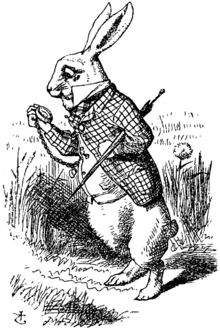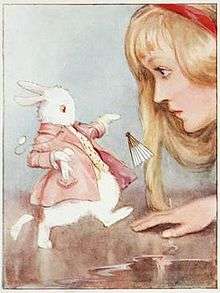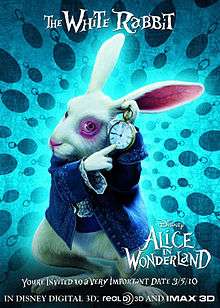White Rabbit
| The White Rabbit | |
|---|---|
| Alice character | |
 | |
| First appearance | Alice's Adventures in Wonderland |
| Created by | Lewis Carroll |
| Information | |
| Nickname(s) | The White Rabbit |
| Species | European rabbit |
| Gender | Male |
| Occupation | Page |
| Nationality | Wonderland |
The White Rabbit is a fictional character in Lewis Carroll's book Alice's Adventures in Wonderland. He appears at the very beginning of the book, in chapter one, wearing a waistcoat, and muttering "Oh dear! Oh dear! I shall be too late!" Alice follows him down the rabbit hole into Wonderland. Alice encounters him again when he mistakes her for his housemaid Mary Ann and she becomes trapped in his house after growing too large. The Rabbit shows up again in the last few chapters, as a herald-like servant of the King and Queen of Hearts.
Personality

In his article "Alice on the Stage" Carroll wrote "And the White Rabbit, what of him? Was he framed on the "Alice" lines, or meant as a contrast? As a contrast, distinctly. For her 'youth', 'audacity', 'vigour', and 'swift directness of purpose', read 'elderly', 'timid', 'feeble', and 'nervously shilly-shallying', and you will get something of what I meant him to be. I think the White Rabbit should wear spectacles. I'm sure his voice should quaver, and his knees quiver, and his whole air suggest a total inability to say 'Boo' to a goose!"[1]
Overall, the White Rabbit seems to shift back and forth between pompous behavior toward his underlings, such as his servants, and grovelling, obsequious behavior toward his superiors, such as the Duchess, and the King and Queen of Hearts, in direct contrast to Alice, who is reasonably polite to everyone she meets. He watches from the side-lines and awaits things to happened, then comes to the rescue mainly for Alice.
Adaptions
Disney film
| White Rabbit | |
|---|---|
| Disney character | |
| First appearance | Alice in Wonderland (1951) |
| Created by |
Lewis Carroll Walt Disney |
| Voiced by |
Bill Thompson (original film) Corey Burton (House of Mouse, Kingdom Hearts, and all other appearances) Jeff Bennett (Kinect Disneyland Adventures) Shigeru Ushiyama (Japanese, Kingdom Hearts series) |
| Information | |
| Species | Rabbit |
| Gender | Male |
| Occupation | Page |
| Nationality | Wonderland |
In Disney's animated version of the book, the Rabbit seems to have the most logic out of all the Wonderland characters. Thus, he is often the straight man for their zany antics; when he asks the Dodo for help on getting the "monster" (Alice) out of his house, Dodo's ultimate solution is to burn the house down, to which the White Rabbit is greatly opposed. At the Mad Tea Party, the Mad Hatter and the March Hare try to "fix" his watch, proclaiming it "exactly two days slow". Through various food they put in the watch (butter, tea, jam, and lemon), the two cause it to go mad, and the Hare smashes it with his mallet. The Rabbit was perhaps most famous for the little ditty he sang at the beginning, "I'm late! I'm late! For a very important date! No time to say hello, goodbye! I'm late! I'm late! I'm late!" The Rabbit was voiced by Bill Thompson.
Some believe the rabbit was late for the announcement of the Queen to the royal garden. The panic the rabbit showed was his fear of losing his head. Upon her arrival (where Alice has been helping to paint the roses red) the cards finish their song and the rabbit blows his trumpet (which he had been carrying for most of his lines) royally introducing the king and queen.
The White Rabbit made a few appearances on the Disney Channel original show, House of Mouse. His most notable appearance was in the episode "Clarabelle's Big Secret", when he confessed to Clarabelle Cow that "I'm not really late, and I don't really have a date. I'm a fraud!". He is seen being grabbed by the reservation clerk Daisy Duck in the show's intro. He was voiced by Corey Burton, who has voiced the Rabbit in all English speaking roles for the character since then. In Aladdin and the King of Thieves, the genie was transformed into him.
The White Rabbit also appears at the Walt Disney Parks and Resorts as a meetable character.
In the PlayStation 2 action-RPG game, Kingdom Hearts and its Game Boy Advance follow-up, Kingdom Hearts: Chain of Memories, the White Rabbit leads Sora, Donald Duck and Goofy to the Queen's palace, worried about being late. His Japanese voice actor was Shigeru Ushiyama.
Tim Burton film
| Nivens McTwisp, The White Rabbit | |
|---|---|
| Alice character | |
 | |
| First appearance | Alice in Wonderland |
| Created by | Lewis Carroll/Tim Burton |
| Portrayed by | Michael Sheen |
| Information | |
| Nickname(s) | The White Rabbit |
| Species | Rabbit |
| Gender | Male |
| Occupation | Page |
| Nationality | Underland |
The White Rabbit works for the Red Queen, but is also a secret member of the Underland Underground Resistance, and was sent by the Hatter to search for Alice. Actor Michael Sheen stated, "The White Rabbit is such an iconic character that I didn't feel like I should break the mould too much." In this film adaption, the White Rabbit is given the name Nivens McTwisp.[2]
McTwisp appears in the video game adaptation of Tim Burton's Alice in Wonderland as a playable character. He attacks using his watch, and can manipulate time.
Švankmajer film
The 1988 Czechoslovak film Alice, noted for its disturbing interpretation of Carroll's story, shows a dark stop-motion version of the character. At the beginning of the film, the White Rabbit starts out as a stuffed rabbit that comes alive in Alice's bedroom and breaks out of his glass case; he leaks sawdust through a hole in his chest. During Alice's pursuit of the White Rabbit in Wonderland, he physically attacks her with paddles, a hacksaw, and a group of skeletal animals. The White Rabbit is also the Queen of Hearts' executioner, using scissors to behead the Mad Hatter, the March Hare, and other characters. Upon awakening from her dream and finding the White Rabbit missing from his case, Alice finds his scissors and resolves to behead him herself.
In popular culture
Television
- The White Rabbit appears in the Once Upon a Time spin-off called Once Upon a Time in Wonderland voiced by John Lithgow - in this show, his first name is revealed to be Percy. He helps the Knave of Hearts to free Alice from Bethlem Royal Hospital in a Victorian Era-type world and bring her back to Wonderland. The Red Queen is also forcing the White Rabbit to be her ears in order to find out about Alice's plans.
- In Star Trek, the 1966 episode "Shore Leave" shows the protagonists visiting a planet where characters of their imagination come to life. The White Rabbit appears to Doctor McCoy early in the episode.
- The White Rabbit appeared in the "Brooke Shields" episode of The Muppet Show performed by Steve Whitmire. The White Rabbit puppet later made a cameo in the wedding scene of The Muppets Take Manhattan, an episode of Donna's Day, and episode 4081 of Sesame Street (where its ears were in the downward position).
- In the Syfy Alice, The White Rabbit is a secret organization that works for the Queen of Hearts and abducts people from the real world, so they can gamble in the Queen's casino. The actual character is represented by a member of the organization called Agent White who kidnaps Jack (Alice's fiance, the Jack of Hearts) and tries to retrieve a magic ring called the Stone of Wonderland from Alice. When it is found out that he failed his mission, the Queen has him executed.
- In Lost, the White Rabbit is alluded to several times in the series. First it is the name of an episode, and Locke claims that Jack is chasing the White Rabbit in the form of his father. The White Rabbit is also the symbol for the Looking Glass Station and it is also carrying a clock with it.
- In an episode of Wizards of Waverly Place, Alex chases the White Rabbit (Justin Russo). He wears white jeans, a white T-shirt, white hair, and big rabbit ears.
- In Leverage Season 5, white rabbit is being mentioned in episode 12 as being the main title and con of the episode
Films
- In Jurassic Park, the character of Dennis Nedry writes a computer program to disable security systems of the park and hide his steps. Samuel L. Jackson's character finds a file called "whiterabbit.obj" that he claims did it all.
- In The Matrix, there are several metaphysical "waking up" metaphors that reference the Wonderland stories. Early in the film, Neo is told to follow the "White Rabbit" and seconds later, his doorbell rings, and when he opens the door he finds a woman with a tattoo of a white rabbit on her shoulder. Later in the film, Morpheus offers him the "red pill" to "find out just how deep the rabbit hole goes". Right before he meets the oracle one can see Night of the Lepus playing on a nearby television, symbolizing Neo's decision to "follow the white rabbit" and to disturb the order of the Matrix.
- In Pacific Rim, there are several metaphysical "waking up" metaphors that reference the Wonderland stories. In the film, Mako Mori is instructed during "mind-meld" training to "do not latch onto memories; let them wash over you" and to aboveall never follow the "White Rabbit". Later in the film, she does this and nearly kills military staff members.
Literature
- In The Looking-Glass Wars, the White Rabbit is re-imagined as Bibwit Harte (an anagram of "White Rabbit"), an albino tutor with super-sensitive hearing.
- In the manga series Alice in the Country of Hearts, written by Quinrose and published by Tokyopop, a character named Peter White is the prime minister of the castle of hearts. He is portrayed as a cruel man who would kill anyone in an instant. He has little in common with the image of the white rabbit other than white rabbit ears, a large oversized pocketwatch, and a suit. He is desperately in love with Alice and often caught rhyming as he speaks. Alice does mention hating him on several occasions and claims to hate "White Rabbit ears" the most.
- In the Stephen King novel The Long Walk, a boy named Stebbins refers to himself as "the White Rabbit type."
- In the manga Pandora Hearts the main character Oz Vessalius is based in the White Rabbit as he is the chain B-Rabbit.
- In the manga series Project ARMS a boy infected with intelligent nano machines code named white rabbit is granted superior speed and jumping ability.
Music
- Jefferson Airplane recorded a song called "White Rabbit", with references to this character and the Wonderland saga in general as metaphors for drug-induced experiences.
- Electric Six's song "Feed my Fuckin' Habit" makes reference to this with the lyrics "Feed my fuckin' habit... Follow the white rabbit" (album I Shall Exterminate Everything Around Me That Restricts Me from Being the Master, 2007).
- My Life with the Thrill Kill Kult's song "A Daisy Chain 4 Satan" has references of a white rabbit in their lyrics about drugs: "I live for drugs... I'm the white rabbit. I freaked out on acid... I'm the white rabbit."
- Egypt Central's song "White Rabbit" makes references to the rabbit: "Your magic white rabbit has left its writing on the wall. We followed like Alice, and just kept falling down the hole."
- Shinedown's song "Her Name is Alice", from the compilation album Almost Alice, uses the line "And the girl that chased the rabbit, drank the wine, and took the pill..." to reference the White Rabbit; the rest of the song also references Alice in Wonderland and Through the Looking Glass.
- Vladimir Vysotsky's song "Белый кролик, Алиса и Додо" ("White Rabbit, Alice and Dodo").[3]
- Marilyn Manson created an album and song titled "Eat Me, Drink Me" in reference to the cookies and drinks labeled "Eat Me, Drink Me" that throughout the story of Alice in Wonderland cause her to grow and shrink. The entire song constantly alludes to the story and characters of Alice in Wonderland, and describes a darker side of the story.
Musical
- The White Rabbit appeared as a banished fairy tale creature in the original Broadway musical Shrek (based on the 2001 film) played by Noah Rivera.
- The White Rabbit was portrayed by Edward Staudenmayer in Frank Wildhorn's musical Wonderland. In the show, he is portrayed as a panicky character with a sarcastic sense of humor. Staudenmayer praised the character's role in the story, saying, "Everything [he has] to say is funny or important." As well as the character that brings Alice to Wonderland in the first place, the Rabbit is also a close ally of her during the course of the show. His sole weapon is his pocket watch, which can turn back time; he uses it to help himself, El Gato the Cheshire Cat, Caterpillar, and Jack the White Knight escape from prison towards the end of the show.
Video games
- In American McGee's Alice, the White Rabbit is responsible for Alice's return to Wonderland. He is first seen as Alice's soft toy, then becomes something that resembles a shriveled version of the John Tenniel illustration. When Alice is chasing him in the Village of the Doomed, he shrinks and goes down a hole. Alice follows him by shrinking herself with a hand-made potion. They meet again in the Wonderland Woods, where he tells her to find Caterpillar. Later, he is killed by the Mad Hatter who crushes him under his foot. He reappears as a minor character in the sequel Madness Returns, first in the opening sequence of the game, and then as a host of some mini-games (along with the Mad Hatter).
- In the Nintendo DS RPG A Witch's Tale, the White Rabbit forces its way before the main character Liddell. It can be an unlockable plush for fighting too.
- Rockstar's game Manhunt features a level called "Kill the Rabbit." In this stage, the player hunts down a man wearing a white rabbit suit, which the game's antagonist describes as "Wonderland fun".
- In the Eye of the North expansion of Guild Wars, finding the boss Nulfastu Earthbound requires the player to follow a white rabbit into a rabbit hole. When the player enters, the boss appears, along with a large amount of other hostile monsters, that easily overwhelms an unprepared group of players.
- There is a reference to the White Rabbit in Castlevania: Aria of Sorrow.
- In Super Mario 64 MIPS the rabbit references the White Rabbit with a few lines, such as "I'm late for an important date."
- In Heart no Kuni no Alice (aka Alice in the Country of Hearts), a dating sim game made for the PC, PSP, and the PS2 with the theme of Alice in Wonderland, has a man named "Peter White" in which Peter White takes the role of the White Rabbit in Wonderland.
Other Influences
A military trench-digging machine developed by the British Royal Navy at the beginning of World War II was originally known as White Rabbit No. 6, but the name was changed to Cultivator No. 6 to conceal its identity.
References
- ↑ Gardner, Martin (1998). The Annotated Alice. Random House. p. 37. ISBN 978-0-517-18920-7.
- ↑ Mainwaring, Rachel (October 26, 2008). "Actor Sheen in Wonderland". Western Mail. Trinity Mirror. Retrieved December 5, 2008.
- ↑ Владимир Высоцкий. "Белый кролик, Алиса и Додо". bards.ru (in Russian). Retrieved September 12, 2016.